No Products in the Cart
Omega-3 Fatty Acids for Dogs with Osteoarthritis?
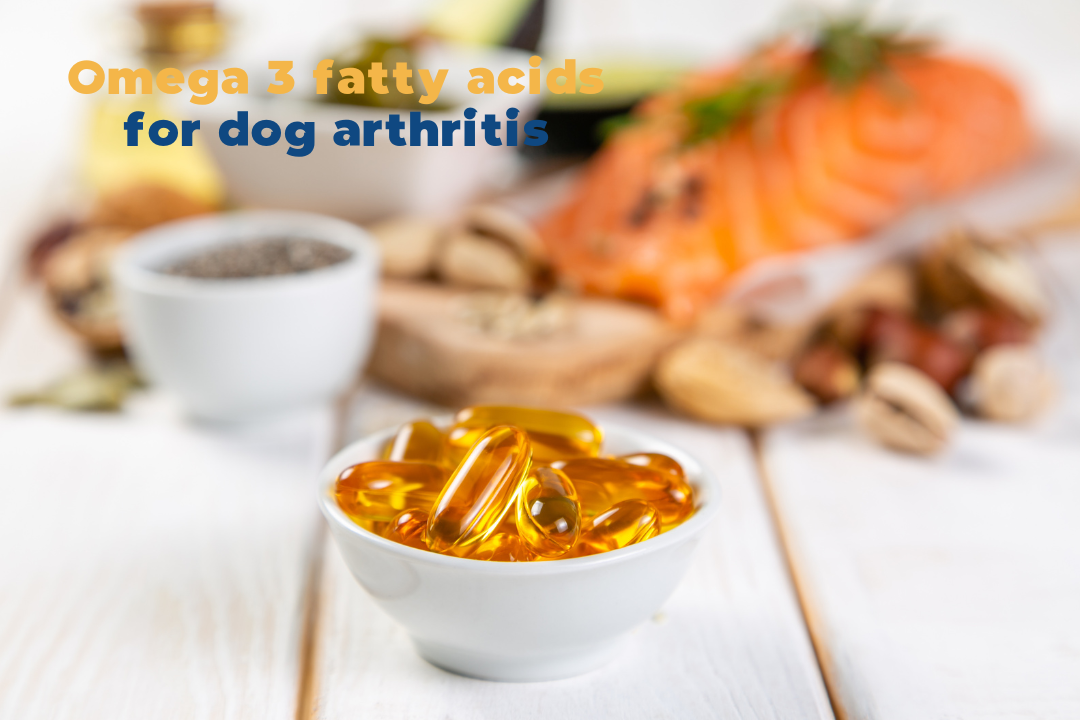
Hi, Jope Squad!
Many advertisements and health articles highlight the benefits of omega-3 fatty acids in cooking oils or fish oils.
And for good reasons! Omega-3 fatty acids' virtues are numerous, and studies demonstrate their importance in the cardiovascular, cerebral, inflammatory, hormonal, and even articular systems.
Did you know that populations that consume high quantities of fatty fish, such as the Inuit or the Japanese, are less affected by cardiovascular diseases?
From a biochemical point of view, omega-3s are part of the family of long-chain polyunsaturated fatty acids (PUFA). In everyday language, they are often referred to as essential fatty acids because they are vital to the body of dogs and cats.
However, your dog or cat does not naturally synthesize enough omega-3 on their own. Therefore, necessary to provide our furry friends with essential fatty acids through their diet.
Dogs and cats don't produce enough omega-3s on their own.
Key facts about omega-3s
- They are among the most studied active ingredients on the market.
- Their benefits are widely demonstrated in humans and pets.
- They act on the cyclooxygenase and lipoxygenase pathways by competing with arachidonic acid ( later transformed into inflammatory molecules).
- The main omega-3s are EPA (Eicosapentaenoic Acid) and DHA (Docosahesaenoic Acid).
- They mostly come from fatty fish, which raises the question of overfishing.
What are omega-3s?
A deep dive into some geeky biochemistry is required to understand what omega-3s are.
Omegas are polyunsaturated essential fatty acids (PUFA), but what does it mean? First, let's take a closer look at the words that make this definition:
- Fatty acids are molecules in fat (so they help store energy) and in cell membranes (so they are everywhere in the body). They also have considerable importance in hormone regulation.
- They are essential because our pets can't produce them by themselves. They need to come from foods or pet supplements.
- They are polyunsaturated by their molecular structure. Meaning omega-3s have several double bonds between two carbon atoms in certain places. The number 3 after their name comes from their first double bond placement. And don't worry about remembering this. It's a purely technical description.
We hope you enjoyed this geeky bite of the article!😊
What you can remember is that we often refer to PUFA and unsaturated fat as "good fats," and doctors and nutritionists often recommend them. You can find them in fatty fishes like Salmon, sardines, herring, or Tuna and from plants, such as chia seed and flaxseed.
Conversely, what we refer to as "bad fats" are saturated fatty acids and fats. You will find them in butter, specific cheeses, and meats.
Are omega-3s safe for my dog?
Omegas-3s are safe for dogs and puppies. However, it's crucial to provide your dog with the right quantities, taking into account their weight, age, activity levels, and overall health. You can work with your veterinarian to figure out the right amount of omega-3s for your pup.
Which Omega-3 fatty acids should I choose for my dog?
Several omega-3 fatty acids exist, and they are close from one to another from a chemical point of view.
When it comes to helping your dog with osteoarthritis, two are to remember:
- Eicosapentaenoic acid, mostly known as EPA
- Docosahexaenoic acid, mostly known as DHA
EPA and DHA found in human and animal bodies directly come from food or synthesized from a specific omega-3 fatty acid called alpha-linolenic acid (ALA). ALA can become EPA, which can then be converted into DHA.
Although this cascade (ALA => EPA =>DHA) can naturally occur in your dog's body, only a small amount of ALA becomes EPA and an even smaller amount of DHA. That's why it's necessary to directly provide your pet with EPA and DHA via food and supplements.
What are the best sources of omega-3 fatty acids for dogs?
You have probably heard that fish oil is a good source of omega-3 fatty acids for dogs. Indeed, good quality fish oil brings significant amounts of omega-3s. Fatty fishes like salmon or sardines generally make for these oils.
But, if humans and other mammals cannot synthesize Omega-3s from scratch, can fish do so? Well, fish depend on a feeding cycle to get their omega-3s. Indeed large and fatty fishes eat smaller fishes that live off zooplankton, also called krill, which resemble tiny shrimps. But unfortunately, krill also cannot produce omega-3s and therefore depends on phytoplankton (microalgae) to produce omega-3s via photosynthesis.
So the source of omega-3s in sea products is phytoplankton because of its photosynthesis capabilities.
Other sources of omega-3s from the earth are less known, such as chia seeds and flaxseeds. And these plants have a high concentration of these essential fatty acids, allowing for a good source of omega-3s in food and supplements for humans. However, pets cannot effectively process the omega-3s present in these plants, and therefore plant-based omega-3s are not recommended for dogs and cats.
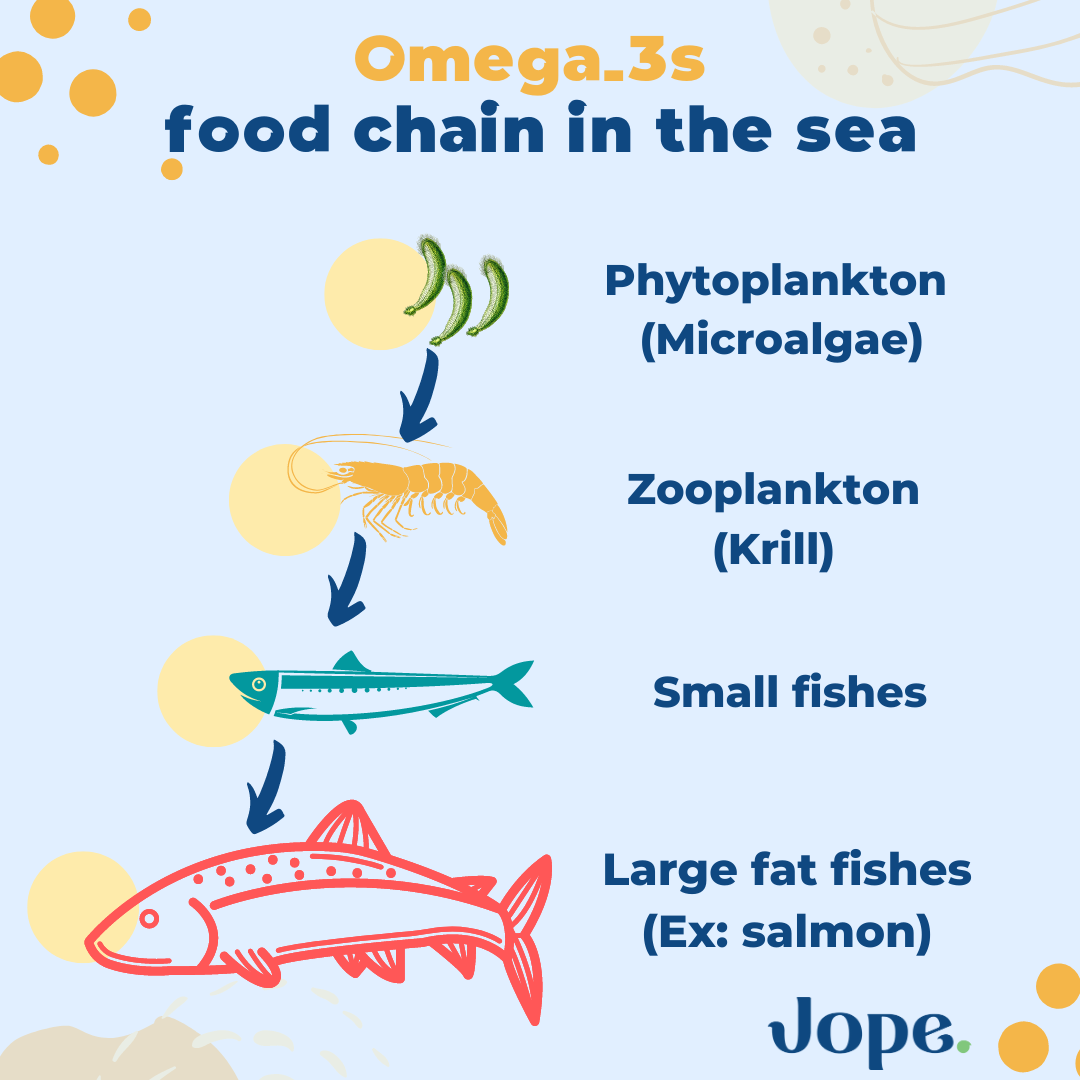
Is your dog's fish oil sustainable?
When thinking about fish oil, one cannot help but stop and think about global overfishing. Nowadays, we use wild fish for human consumption, feeding farmed fish (small fish to feed salmon, for example), making meals for farm animals, and oils and supplements for pets.
If you've looked into the situation, you know that the environmental protection associations and the fishing industry see a danger in the balance of the marine ecosystem.
However, there are no perfect solutions for finding sources of omega-3s fatty acids, which are essential to our pets and us.
One approach is to look for sustainable sources of sea omega-3s by prioritizing fish oils from fishes low on the food chain we saw above—For example, sardines, mackerels, and anchovies.
How do omega-3s help dogs with osteoarthritis?
We saw earlier that omega-3s and, more specifically, EPA and DHA come from linoleic acid (ALA).
When eating oils or any fatty food, you will get omega-3s and omega-6s. Omega-6s are interesting as they are used differently than omega-3s by our bodies and impact inflammation in another way, fueling inflammation.
One important omega-6 is linoleic (not linolenic) acid, abriviated by LA. Through chemical transformations, LA can become arachidonic acid (AA).
As a result of chemical reactions in the body, AA and EPA/DHA will compete to become part cell membranes. Remember your high school biology classes: the cell membrane is a phospholipid bilayer composed of fatty acids.
Commonly, the cell membrane is altered with time, leaving the fatty acids (omega-6s and omega-3s) free outside the membrane.
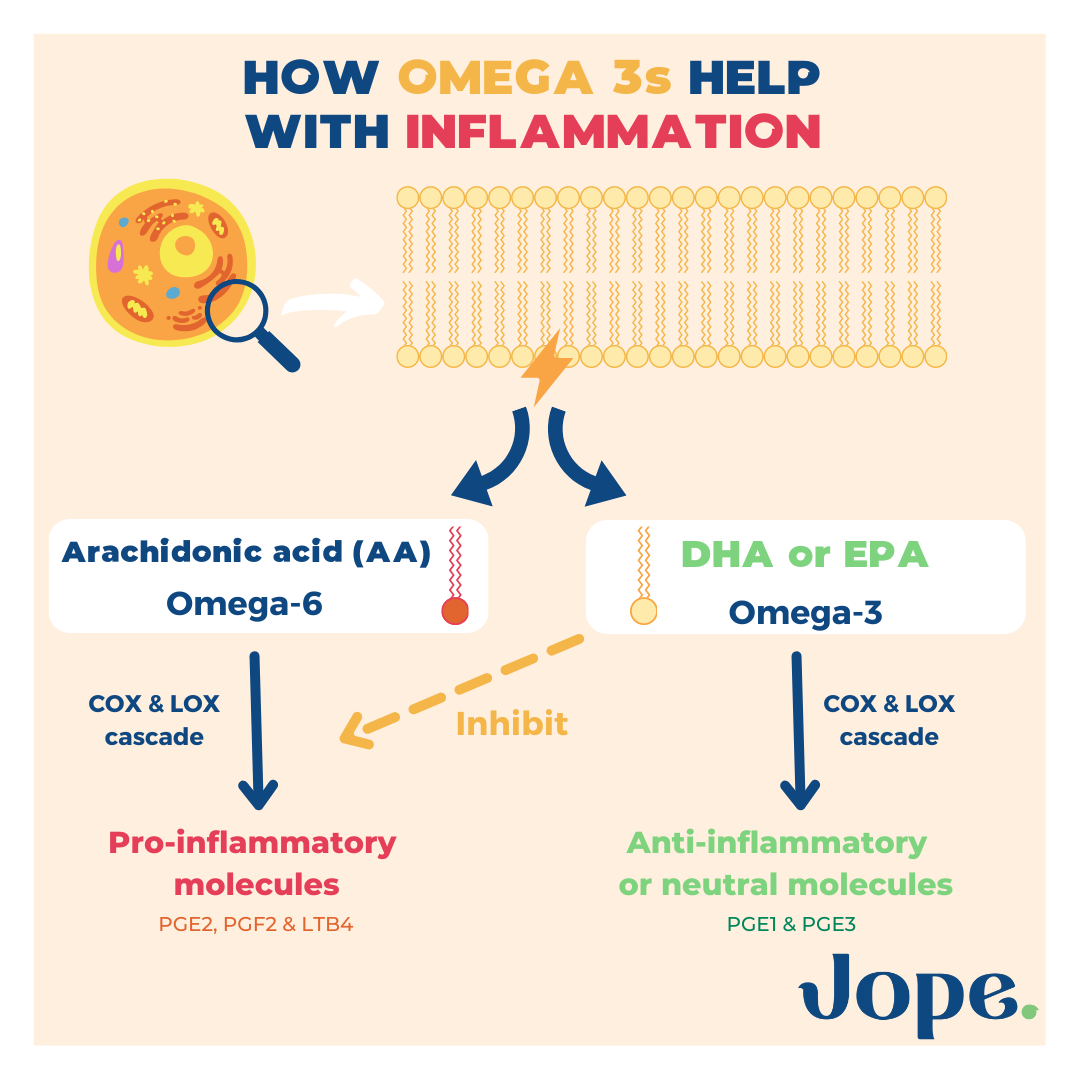
Once membrane alteration occurs, cyclooxygenases or lipooxygenases (special enzymes) transform the free omega-6s and omega-3s fatty acids. These transformation reactions lead to the creation of:
- pro-inflammatory molecules (prostaglandins, thromboxanes, and leukotrienes such as PGE2, PGF2, or LTB4) with omega-6s (especially arachidonic acid) and,
- anti-inflammatory molecules with omega-3s( EPA and DHA).
What matters is that the omega-6s/omega-3s ratio needs to remain low. Indeed, if this ratio goes up, meaning more omega-6s, the body produces more pro-inflammatory molecules.
The other power of EPAs resides in their ability to inhibit the arachidonic acid transformation cascade, limiting the quantities of pro-inflammatory molecules produced.
Inflammation has many negative impacts on the body, and it is also the cornerstone of osteoarthritis.
Therefore, stopping the inflammation cascade is vital to limit the progression of osteoarthritis, and this is where omega-3s come into play: their transformation allows your dog's body to produce anti-inflammatory molecules and inhibits the production of pro-inflammatory molecules.
Omega-3 fatty acids for dogs with osteoarthritis are scientifically proven to help
In the past decades, scientists conducted over 20 studies looking at omega-3s in osteoarthritic dogs and the conclusions were unanimous: omega-3s showed significant benefits on dogs' mobility.
These studies lead to a consensus among veterinarians that omega-3s help with dog osteoarthritis.
1. Omega-3s help dogs with osteoarthritis by reducing lameness and discomfort
In a 72 dogs study, omega-3s reduce lameness and discomfort.
The scientific community studied the benefits of omega-3s on inflammation and joint health for decades in humans and dogs.
A robust 2016 scientific study with the following criteria gave exciting results. Criteria:
- Prospective study: the population is chosen specifically for the study (in contrast, a retrospective study selects the population on past data).
- Randomized: the population is split randomly to receive the different treatments.
- Placebo-controlled: two groups are present in the study. One receives omega-3s in oil, and the other gets a placebo oil. The split allows comparing the efficacy of the treatment to the placebo effect.
- Double-blinded: neither pet parents nor veterinarians know which treatment the dogs receive.
- Single assessor & VAS score: the same person is responsible for assessing lameness on every dog and uses a lameness/discomfort visual analog scale (VAS)
- Seventy-eight dogs were in the study.
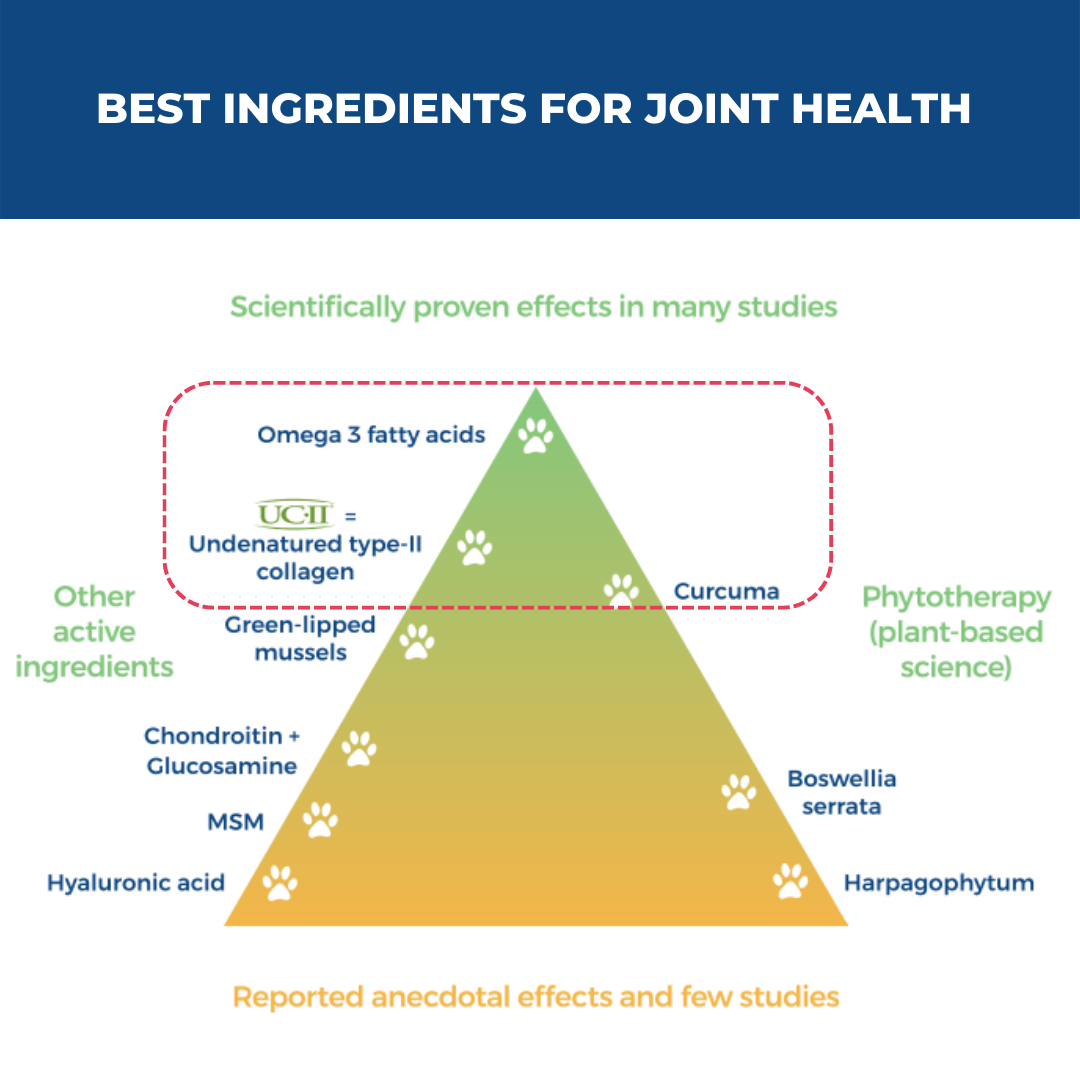
2. Omega-3 fatty acids improve mobility and the performance of daily activities
In a 30 dogs study, omega-3s improved vertical peak force in dogs with osteoarthritis.
Veterinarians and scientists have several ways to assess dog lameness and mobility. If they want to use proper objective methods, they use technology instead of human opinions. For example, when researchers are looking at lameness, they can use a measure called Peak Vertical Force (PVF). PVF assesses the force the dog applies on a ground plate while running or walking.
A 2013 study used this objective measure to evaluate the effects of omega-3s on locomotor disability. The scientists fed dogs of group one omega-3s enriched foods while group two ate classic food. As a result, the Peak Vertical Force measure in group one increased by seven while remaining the same in group two.
The increase in PVF means the dogs can apply more pressure on their limb(s) while running because they feel less pain and discomfort.
This study is fascinating because only a few molecules, like Undenatured type II collagen, successfully demonstrated Peak Vertical Force improvement. On the contrary, chondroitin and glucosamine have not improved the PVF score, an objective measure with no bias.
3. Omega-3s help rats with osteoarthritis have a better recovery
A 2014 study on arthritic mice confirmed the importance of a diet rich in omega-3s in limiting the damage caused by osteoarthritis. In contrast, high omega-6s and saturated fatty acids diets worsened the mice's condition.
What are the other benefits of omega-3s for dogs?
Omega-3s are vital in fighting osteoarthritis in dogs and cats. But they have other known incredible benefits:
- Helping puppies' and kittens' brain and retina developments.
- Boosting dogs' ability to fight cancer and autoimmune disease.
- Aids in maintaining a healthy heart and kidneys.
- Improving the skin and coat of dogs, especially when they have atopic dermatitis.
- Reducing anxiety, depression, and aggressivity.
FAQs
What does Omega-3 Fatty Acid do for dogs?
Omega-3 fatty acids, particularly EPA and DHA derived from fish oil, play a vital role in canine joint health by directly targeting inflammation via the LOX and COX inflammatory pathways. According to veterinary experts at institutions such as Banfield Pet Hospital, regular supplementation with EPA and DHA supports joint mobility, supports a normal inflammatory response, and alleviates symptoms associated with occasional stiffness and soreness, significantly enhancing your dog’s overall quality of life.
How much Omega 3 should I give my dog?
Determining the correct dosage of Omega-3 depends primarily on your dog's weight and health status. General veterinary guidelines recommend approximately 75–100 mg of combined EPA and DHA per kilogram of body weight daily, though individual needs may vary. For precise dosage guidance tailored specifically to your dog’s health needs, consult with your veterinarian.
Should I give my dog omega 3 every day?
Yes. Daily Omega-3 supplementation is strongly advised by veterinarians to "maintain consistent anti-inflammatory effects and ongoing joint support". Advanced joint chews offer an optimal daily solution, combining high quantities of EPA and DHA along with UC-II® collagen, curcumin, clinically proven ingredients to provide superior joint support and quick relief from occasional joint discomfort. Regular daily use helps sustain your dog's joint health, comfort, and overall mobility.
What is the best brand of omega-3 supplements?
Veterinarians consistently recommend reputable brands that ensure purity, potency, and quality assurance. Advanced joint chews stand out by blending potent Omega-3s (EPA and DHA) with UC-II® collagen and curcumin for comprehensive joint support. Nordic Naturals is another highly trusted veterinary-recommended brand specifically known for the purity and quality of their fish oil products. Both Jope and Nordic Naturals are recognized for delivering high-quality, veterinarian-approved Omega-3 supplements you can trust for your dog’s daily joint health.











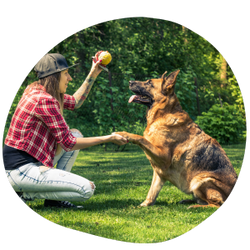
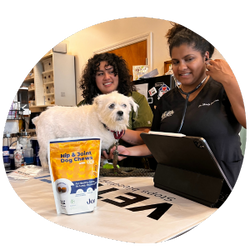
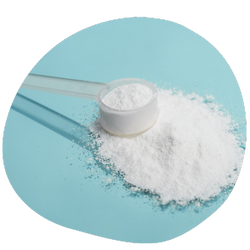


Leave a comment